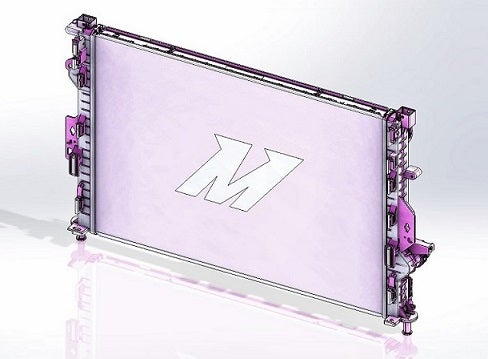
Focus On Cooling! Mishimoto's Focus ST Radiator R&D, Part 1: Problem and Solution Analysis
Our engineering team often tackles complex problems to provide ideal solutions for customers. This is true for all our product lines, across a broad range of vehicle makes and models. We are not strangers to Ford's lineup of EcoBoost models, and our team is quite familiar with the issues that exist for each. In general, we've found that the stock liquid cooling systems are not handling the abuse from heavy-footed ST (Fiesta, Focus) and Mustang owners. Each model shows deficiencies in coolant heat transfer, rising oil temperatures, and power-crippling heat-soak.
In our effort to solve each problem, we've started a ton of awesome projects, performed unique testing, and we've had a blast working with the EcoBoost community. Now, we turn our attention to the Focus ST radiator. This component has become the elephant in the room, if the room were the paddock at the track. All around the world, Focus owners are hitting the track expecting a fun day of battles against physics, rev-match downshifts, and a mile-wide smile. Instead, the reality is that Focus owners are glued to the temperature readouts, begging for another lap before limp-mode forces them to run to the pits while cursing Ford engineers.
All that will soon end! We've already provided our rendition of an oil cooler setup, and we are now deeply involved with creating a radiator that will get you guys back on track. So begins the development of new Focus ST parts!
Initial Development
We started this project in a slightly different manner than our typical R&D process. Normally, we would remove the stock radiator and take measurements to begin modeling our own rendition. For the Focus, we were lucky enough to have access to extensive 3D models of the front-end, including the stock radiator and surrounding components. This meant initial modeling would be a bit easier.
We still brought a vehicle into the shop to grab some additional measurements of the stock heat exchanger.
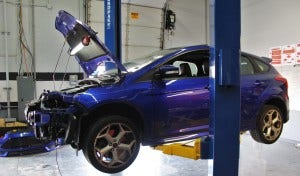
Focus ST on lift for parts evaluation
The Focus engine bay and heat exchanger stack is such a compact setup!
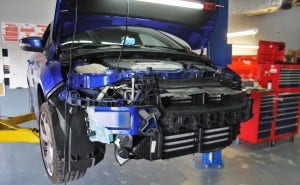
Focus ST on lift for parts evaluation
Once we had all the data from both the stock model and the test vehicle, we started designing our counterpart. In doing so, we put together a neat overlay showing the stock radiator and our design. Warning!! These are pretty cool renders and could be considered NSFW!
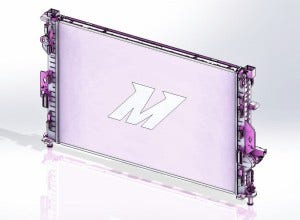
Ford Focus ST radiator overlay render, front
The two colors denote the different radiators, purple being the Ford radiator and light blue being our counterpart. These overlays show how we've emulated the various mounting points on the stock radiator.
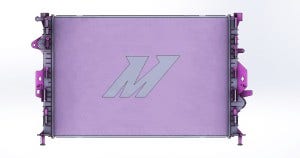
Ford Focus ST radiator overlay render, front
Here's a look at the back side of the radiator overlay.
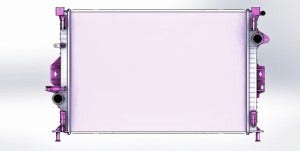
Ford Focus ST radiator overlay render, back
One of the big comparison points with a performance radiator is often the core thickness. Greater core thickness generally means more fluid capacity as well as more heat-transfer contact points. Both of these characteristics can have a significant impact on decreasing the coolant temperature from the inlet to the outlet. Below is a render showing the core thickness.

Ford Focus ST radiator overlay render, thickness
The stock core measures 27mm thick. Our first prototype is being designed at 34mm thick, which should provide a nice increase in fluid capacity.
Details of the core itself cannot be seen in the renders here, but we do have plans to improve on the stock design. Heat transfer is greatly affected by the surface area of the fins within the core. Fins work to transfer heat from the internal coolant tubes to the air passing through the core. By increasing the density of the fins, shorter fin with decreased pitch, we can make a huge impact on the overall surface area, which should result in a more efficient heat exchanger. More on this later on!
The end tanks are relatively complex on this radiator, as shown in the next couple of overlay renders.
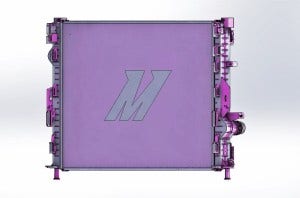
Ford Focus ST radiator overlay render, end tank
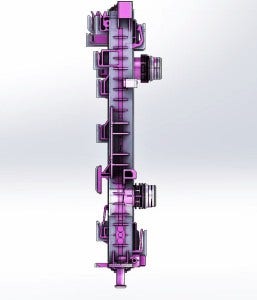
Focus ST parts R&D
Coming Up!
After we finalize our design with a few more tweaks, we can separate the two models and provide some renders of our first prototype radiator. In addition, we will be working up a functional prototype for testing purposes. We're going to be working feverishly to bring you guys a solution!
Keep an eye on our blog for more information regarding upcoming Focus ST parts.
Thanks for reading!
-John




